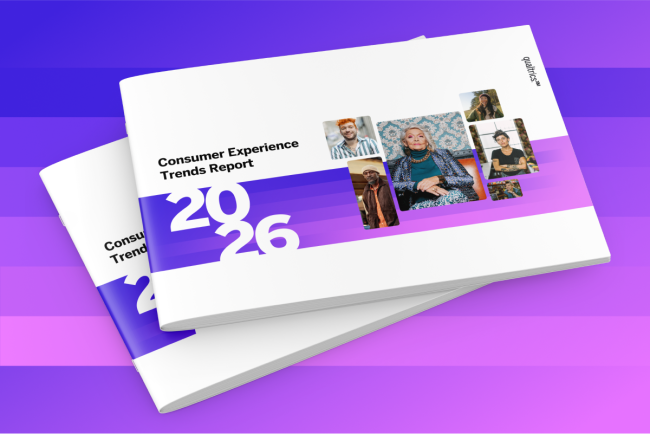Quick-serve restaurants (QSRs) like McDonald’s or Dunkin Donuts are a staple in America’s dining landscape. Recent new technologies give brands fresh opportunities to serve customers, including AI-supported drive thru ordering and self-serve kiosks, with mixed success. As economic uncertainty forces consumers to think twice about their budgets, non-essentials like fast food can be among the first to see less spending. New research from Qualtrics provides insights into consumers’ mindsets around QSRs and how to earn their business.
“QSRs compete in an unforgiving environment, where brief encounters and low switching costs mean brands have little time to create customer experiences that lead to lasting relationships,” said Isabelle Zdatny, head of thought leadership at Qualtrics XM Institute. “But the high-volume nature of the industry means QSRs produce a tremendous amount of operational and behavioral data that, when combined with experience insights, allow forward-thinking brands to anticipate customer needs and deliver personalized experiences that build loyalty one interaction at a time.”
Order satisfaction: in-person experiences Win
Overall, consumers are highly satisfied when they place their order in person, whether at the counter or a drive thru. There is a significant dropoff in satisfaction when ordering at a kiosk, and customers are less and less pleased with this technology – satisfaction is down 4 percentage points since the start of the year.
Satisfaction by ordering method
At the counter - 85%
Via restaurant app - 55%
At the drive through - 83%
Via third-party app - 79%
At a kiosk - 70%
Decision drivers: cravings rule
With so many restaurant options available, what is it about QSRs that draw customers to choose them? The research shows that most people pick these restaurants to fulfill a craving, as a treat, or because they’re convenient options, rather than trying to earn loyalty points or because it’s part of their usual routine. Almost nobody is looking for a healthier option when they decide to eat at a QSR.
Percentage of consumers who said this motivating factor was a reason to choose the restaurant
Had a craving - 43%
To treat myself - 34%
Most convenient option - 32%
Fast service/short wait times - 28%
Had a drive-thru - 22%
Promotion or offer - 16%
Someone else chose it - 14%
Online/in-app ordering - 13%
Part of my routine/habit - 11%
To earn points/rewards - 10%
Looking for a healthier option - 6%
The parent perspective
Parents are generally less satisfied with their overall QSR experiences, but the data indicates they are choosing specific restaurants instead of looking for a QSR in general. One potential reason behind this? They’re also more likely to let someone else choose where they eat. Parents are more likely than people without kids to prioritize rewards programs and online or in-app ordering.
Nostalgia also stands out among parents, who are 9 points more likely to report that restaurants evoke fond memories than consumers without children.
Implications for QSR brands & leaders
The good news for the QSR industry is that customer satisfaction remains consistently high, with 82% of consumers feeling satisfied with their experiences at quick-serve restaurants. Satisfaction has held relatively steady for the past two quarters between 82-85%. But at a time when two-thirds of fast food customers cut spending after a poor experience, it’s essential to create a positive experience every time.
“Economic uncertainty and technological disruption are reshaping consumer priorities too fast for traditional research cycles to keep up,” according to Zdatny. “QSRs that stay continuously attuned to changing customer preferences will be able to identify these evolving needs and adjust their operations before competitors can react, ensuring their investments deliver actual customer value and sustainable competitive advantage.”
Recommendations for QSR leaders looking to enhance customer experiences and win over customers:
- Improve self-service technology: With kiosk satisfaction scores falling 4 points this year alone, brands risk these self-service technologies becoming more of a customer deterrent than an advantage. To improve user experience and functionality, focus on intuitive interface design, simplified menu navigation, and clear visual cues that guide customers through ordering. Ensure staff are positioned nearby to assist when needed rather than leaving customers to struggle alone.
- Invest in high-performing service channels: Counter service (85% satisfaction) and drive-thru (83% satisfaction) significantly outperform digital alternatives, making them competitive differentiators rather than legacy operations. Focus on operational excellence through employee training, technology integration that enhances rather than replaces human interaction, and process optimization that maintains speed without sacrificing service quality. These foundational touchpoints deserve increased investment, not just maintenance.
- Design for in-the-moment decisions: With 43% of customers choosing QSRs to fulfill cravings and 32% selecting the most convenient option, brands should optimize for spontaneous visits rather than planned consideration. Focus on location visibility and accessibility, menu simplification that highlights popular items, and marketing that triggers immediate desire through sensory cues and emotional appeals. Speed and simplicity should guide operational decisions, as customers are deciding in the moment rather than researching options.
- Reevaluate loyalty programs: While only 10% of customers visit primarily to earn points, loyalty programs serve dual strategic purposes – driving repeat visits among enrolled members and connecting anonymous transactions to individual customer profiles. Focus on program design that encourages enrollment and ongoing engagement to capture purchase patterns and preferences, then use these insights to deliver personalized experiences that actually motivate return visits. The goal is creating a feedback loop where better data enables better experiences that drive genuine loyalty.
This data comes from Qualtrics® Instant Insights. It comes from nearly 25,000 US consumers, collected between Sept 2024-April 2025. With Instant Insights, organizations have access to a library of competitive positioning, industry benchmarks, and emerging consumer trends and behaviors powered by data from Qualtrics’ own proprietary research and unique operational and industry data sets from partners.



